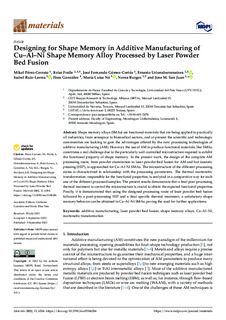| dc.rights.license | Attribution 4.0 International | * |
| dc.contributor.author | Fraile, Itziar | |
| dc.contributor.other | Pérez Cerrato, Mikel | |
| dc.contributor.other | Gómez Cortés, Jose F. | |
| dc.contributor.other | Urionabarrenetxea, Ernesto | |
| dc.contributor.other | Ruiz Larrea, Isabel | |
| dc.contributor.other | González, Iban | |
| dc.contributor.other | Nó, María Luisa | |
| dc.contributor.other | Burgos, Nerea | |
| dc.contributor.other | San Juan, José M. | |
| dc.date.accessioned | 2022-11-09T14:30:37Z | |
| dc.date.available | 2022-11-09T14:30:37Z | |
| dc.date.issued | 2022 | |
| dc.identifier.issn | 1996-1944 | en |
| dc.identifier.other | https://katalogoa.mondragon.edu/janium-bin/janium_login_opac.pl?find&ficha_no=168377 | en |
| dc.identifier.uri | https://hdl.handle.net/20.500.11984/5816 | |
| dc.description.abstract | Shape memory alloys (SMAs) are functional materials that are being applied in practically all industries, from aerospace to biomedical sectors, and at present the scientific and technologic communities are looking to gain the advantages offered by the new processing technologies of additive manufacturing (AM). However, the use of AM to produce functional materials, like SMAs, constitutes a real challenge due to the particularly well controlled microstructure required to exhibit the functional property of shape memory. In the present work, the design of the complete AM processing route, from powder atomization to laser powder bed fusion for AM and hot isostatic pressing (HIP), is approached for Cu–Al–Ni SMAs. The microstructure of the different processing states is characterized in relationship with the processing parameters. The thermal martensitic transformation, responsible for the functional properties, is analyzed in a comparative way for each one of the different processed samples. The present results demonstrate that a final post–processing thermal treatment to control the microstructure is crucial to obtain the expected functional properties. Finally, it is demonstrated that using the designed processing route of laser powder bed fusion followed by a post–processing HIP and a final specific thermal treatment, a satisfactory shape memory behavior can be obtained in Cu–Al–Ni SMAs, paving the road for further applications. | en |
| dc.description.sponsorship | Gobierno Vasco-Eusko Jaurlaritza | es |
| dc.description.sponsorship | Gobierno de España | es |
| dc.language.iso | eng | en |
| dc.publisher | MDPI | en |
| dc.rights | © 2022 The Authors | en |
| dc.rights.uri | http://creativecommons.org/licenses/by/4.0/ | * |
| dc.subject | additive manufacturing | en |
| dc.subject | laser powder bed fusion | en |
| dc.subject | shape memory alloys | en |
| dc.subject | Cu–Al–Ni | en |
| dc.subject | martensitic transformation | en |
| dc.title | Designing for Shape Memory in Additive Manufacturing of Cu–Al–Ni Shape Memory Alloy Processed by Laser Powder Bed Fusion | en |
| dcterms.accessRights | http://purl.org/coar/access_right/c_abf2 | en |
| dcterms.source | Materials | en |
| local.description.peerreviewed | true | en |
| local.identifier.doi | https://doi.org/10.3390/ma15186284 | en |
| local.relation.projectID | info:eu-repo/grantAgreement/GV/Elkartek 2020/KK-2020/00047/CAPV/Desarrollo de materiales cerámicos y metálicos de altas prestaciones para fabricación avanzada/CEMAP | en |
| local.relation.projectID | info:eu-repo/grantAgreement/GE/Proyectos de I+D de Excelencia 2017/FIS2014-58950-C2-1-P/ES/Superelasticidad y memoria de forma a micro y nano escala: ensayos nanomecanicos y microscopia electronica in-situ/ | en |
| local.relation.projectID | info:eu-repo/grantAgreement/GV/Programa predoctoral de formación del personal investigador no doctor 2019-2020/PRE_2019_2_0268/CAPV// | en |
| local.contributor.otherinstitution | https://ror.org/000xsnr85 | es |
| local.contributor.otherinstitution | https://ror.org/022wqqf69 | es |
| local.contributor.otherinstitution | Tecnun | es |
| local.source.details | Vol. 15. Nº 18. September, 2022 | en |
| oaire.format.mimetype | application/pdf | |
| oaire.file | $DSPACE\assetstore | |
| oaire.resourceType | http://purl.org/coar/resource_type/c_6501 | en |
| oaire.version | http://purl.org/coar/version/c_970fb48d4fbd8a85 | en |








